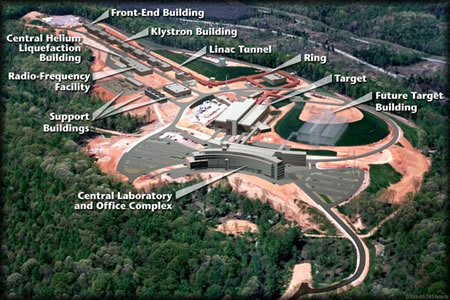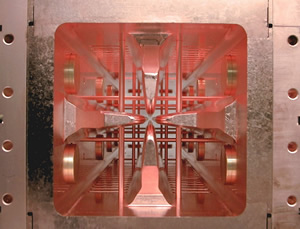|
Faced with a deadline less than four months away, scientists and engineers
with the Lawrence Berkeley National Laboratory cleared a major hurdle
for completing their part of the Spallation Neutron Source (SNS), the
accelerator-based facility that will provide the most intense pulsed-beams
of neutrons ever available for scientific research and industrial development.
On Friday, January 25, at around 4:30 p.m., they drew the first ion beam
out of the radio-frequency quadrupole (RFQ) accelerator, which is the
third and perhaps most technically challenging of the four components
in the SNS front-end system.
"The 2.5 million electron volts [MeV] beam came out at a current
of 24 milliamps [mA] on the very first try!" said Rick Gough, the
physicist who heads the Ion Beam Technology program for Berkeley Lab's
Accelerator and Fusion Research Division (AFRD). "A full characterization
of the beam with peak-currents up to 33 mA is now underway. This current
is already sufficient to support operation of the SNS at 1.2 MW average
power."
 |
 |
|
|
 |
Leaders of the SNS Front-End Group
include (from left) Rod Keller, John Staples, and Alex Ratti |
|
|
Said Rod Keller, the physicist who serves as senior team leader of the
SNS Front-End Group, "To save costs, we had to make a production
model and test it without the advantage of first working with a prototype.
This is risky business with an RFQ accelerator because you never know
what you have until you test it. Either your accelerator works or it doesn't,
and in this case it worked extraordinarily well!"
The design of the SNS RFQ was led by physicist John Staples, who also
led the design of the four previous RFQs built at Berkeley Lab.
"At nearly four meters in length, this is the longest RFQ we've
ever built, which presents a big challenge in terms of field stability
and tuning," says Staples. "This RFQ also had to handle the
most powerful beam at a higher current and operate at a duty factor (the
fraction of system operational time in which a beam is actually produced)
about 60 times greater than any we've built before."
"That all of these challenges were so successfully met is a credit
to the team effort that has characterized the work of the Front-End Group
throughout this project," says Gough.
With the successful test of the RFQ the 40 scientists, engineers and
technicians who comprise the SNS Front-End Group successfully completed
the third stage of their four-stage assignment. In the spring of 2001
the group commissioned the negative hydrogen ion source and low-energy
beam transport system. The fourth and final component of the SNS front
end, the medium-energy beam transport (MEBT) system, has already been
built and will be attached to the RFQ for testing later in the spring
of 2002. When testing is complete, the front end's components will again
be separated for shipment to Oak Ridge National Laboratory (ORNL) which
will be the host institute for the SNS.
The SNS project is a collaboration between Berkeley Lab, ORNL, and the
Argonne, Brookhaven, Jefferson, and Los Alamos national laboratories.
When construction at ORNL is complete and it goes online (scheduled for
the year 2006), the SNS will be capable of delivering an average of 1.4
million watts of neutron beam power onto a target, more than 10 times
the capacity of today's most powerful pulsed neutron sources. The scattering
of these neutrons when they strike experimental samples will reveal to
scientists and engineers the most intimate structural details of a wide
range of materials.
 |
|
| With Oak Ridge National
Laboratory, where the Spallation Neutron Source is located,
Argonne, Berkeley, Brookhaven, Jefferson, and Los Alamos
national laboratories are building the facility's major
components. |
|
The SNS generates its neutron beams through the combination of a linear
accelerator (linac) and accumulator ring, which result in the production
of a one-microsecond long pulsed beam of protons, energized to about one
billion electrons volts. This yields a pulsed beam of hot neutrons that
is immediately cooled to room or even lower temperatures and directed
into samples for nondestructive neutron scattering studies.
Each of the partner labs collaborating on the SNS was delegated a specific
responsibility. Berkeley Lab's responsibility, the front-end system, is
required to create a beam of negative hydrogen ions and prepare it for
delivery into the SNS linac. Negative hydrogen ions are accelerated in
the front-end system and the linac because they lend themselves to efficient
injection into the accumulator ring. As they are injected into the accumulator
ring, the hydrogen ions are stripped of their electrons and converted
into positively charged hydrogen ions (protons).
The first two components of the front-end system, the ion source and
the low-energy beam transport, combine to create a continuous beam of
negative hydrogen ions. It is the role of the RFQ to prepare these negative
ions for injection into the SNS linac by breaking the beam into discrete
bunches at radiowave-sized pulse lengths, then accelerating those pulses
to 2.5 MeV while simultaneously keeping them focused in a narrow beam.
The SNS RFQ consists of an encased cavity containing four strategically
modulated copper electrodes or vanes between which radio-frequency electric
fields are applied. These fields act on the beam both longitudinally and
transversely to first establish the bunch structure, and then (due to
increased depth of the vane modulations) accelerate the bunched beam to
the full energy of 2.5 MeV.
 |
 |
|
|
 |
Water-cooled copper vanes of the SNS
radio-frequency quadrupole focus and accelerate bunches of negative
hydrogen ions. |
|
|
Because of the quadrupole arrangement of the vanes, these fields also
overcome the effects of space-charge forces that would otherwise cause
the beam's negatively charged ions to fly apart.
Careful temperature control of the RFQ structure is required to keep things
properly working as the radio frequency power used to manipulate the ions
also heats up the inner surfaces of the RFQ cavity. Usually, thermal expansion
effects are compensated by moveable mechanical "tuners," but
Steve Virostek of Engineering Division (ED), the lead mechanical engineer
for the RFQ system, working with ED designer, Matt Hoff, came up with
a unique water-cooling scheme that is far more cost-effective and also
boosts the system's reliability.
"The design decisions to achieve dimensional stability of the RFQ
during startup conditions and normal operating conditions were based mainly
on Steve's analyses of the transient heat loads and heat distribution,"
says ED's Dick DiGennaro, chief engineer for the front-end system.
A series of tiny water channels run through the RFQ's cavity wall and
copper vanes. The water temperature in the wall is held at a constant
24 degrees Celsius, while the water temperature running through the vanes
is varied as needed.
Explains Virostek, "This cooling scheme, along with 80 pre-machined,
fixed slug tuners has proven to be a reliable and effective solution to
tuning the SNS RFQ. The cost savings as compared to a moveable tuner system
is as much as $200,000 which is a significant fraction of the total RFQ
fabrication cost."
The beam generated during the RFQ testing was directed into various devices
for diagnostic purposes. When beam testing and characterization are completed,
the RFQ will be shut down for installation of the remaining MEBT parts.
The role of the MEBT is to create short gaps in the beam by chopping it
into mini-pulses of 645 nanoseconds duration with separations of 300 nanoseconds
in order to facilitate the beam's ultimate extraction from the SNS accumulator
ring.
"The completion and successful testing of the SNS RFQ has been a
huge milestone for us and a terrific accomplishment for Berkeley's Front
End team," says Gough. "As we approach the final countdown,
I'm pleased to say that we're still within budget and on schedule to begin
shipping to ORNL in June."
In addition to those already mentioned, other key members of the SNS
Front-End Group include project manager Ron Yourd and lead electrical
systems engineer Alex Ratti.
Additional information:
|

